Outside broadcasting
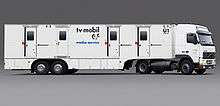
Outside broadcasting (OB) is the electronic field production (EFP) of television or radio programmes (typically to cover television news and sports television events) from a mobile remote broadcast television studio. Professional video camera and microphone signals come into the production truck for processing, recording and possibly transmission. The mobile production control room (PCR) is known as a "production truck", "scanner" (a BBC term), "mobile unit", "remote truck", "live truck", "OB van", "OB Truck" or "live eye". In the United States an "OB van" is smaller in size than a production truck and generally requires two or three people in the field to manage.
History
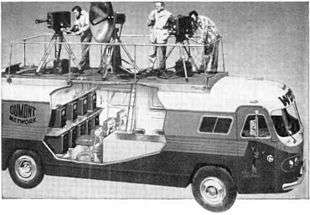
The BBC's first Outside Broadcast truck MCR 1, short for mobile control room, was built by the joint Marconi-EMI company and delivered to the BBC just in time to televise the Coronation Procession of King George VI in May 1937. MCR 2 was identical to MCR 1 and was delivered in the summer of 1938. The MCRs could handle three cameras. Initially they were standard Emitrons, but were later supplemented by Super Emitrons, which performed much better than the standard ones in low light. The MCRs were built on the chassis of an AEC Regal single decker bus.
After the Second World War, the joint company Marconi-EMI ended. The BBC ordered two 3-camera MCRs from EMI. The cameras were equipped with CPS tubes, had electronic viewfinders and a 3 lens turret. MCR 4 was delivered in time to be used on the 1948 Olympics.[1]
After developing colour television in the mid 1960s, the BBC began to develop a fleet of colour OB units, known as CMCRs. These trucks were known as Type 2 scanners and were, at the time, completely state of the art. Type 2 scanners first came equipped with Pye PC80 cameras but these were soon superseded by EMI's 2001 colour cameras. These trucks would remain in service through the 1970s and into the mid 1980s. Throughout this time, they would see use on some of the BBC's most prestigious programmes, including Royal Events, Dr Who, Wimbledon Tennis, and Question Time.
Although made from converted HGVs, inside these trucks were incredibly cramped as a result of housing an entire mobile television studio. These were normally made up of three sections:
- A section to house the camera control units, or CCUs, and camera monitoring equipment. Being so large and complex, these cameras required a team of skilled engineers to keep them functioning. During a production, the camera operator would control the pan and the focus but it was the engineer who controlled the exposure and the colour balance.
- A section for the production crew, lead by the director, who would orchestrate the over all production.
- A section for the sound crew which housed their mixing desk and other sound equipment. From here the sound crew controlled not only the sound of the programme but all the production communications which allowed the whole crew to communicate to one another. Without which the production would undoubtedly grind to a halt.[2]
Modern applications
In the past many outside broadcasting applications have relied on using satellite uplinks in order to broadcast live audio and video back to the studio. While this has its advantages such as the ability to set up virtually anywhere covered by the respective geostationary satellite, satellite uplinking is relatively expensive and the round trip latency is in the range of 240 to 280 milliseconds.[3] As more venues install Fibre, this is increasingly used. For news gathering, contribution over public internet is also now used. Modern applications such as hardware and software IP codecs have allowed the use of public 3G/4G networks to broadcast video and audio. The latency of 3G is around 100–500 ms, while 4G is less than 100 ms.[4]
Interior
A typical modern OB van is usually divided into five parts.
- Parts of the television crew are located in the first and largest part, the video production area. The television director, technical director (vision mixer), assistant director, character generator (CG or graphics) operator and television producers usually sit in front of a wall of video monitors. The technical director sits in front of the video switcher. The video monitors show all the video feeds from various sources, including computer graphics, professional video cameras, video tape recorder (VTR), video servers and slow-motion replay machines. The wall of monitors also contains a preview monitor showing what could be the next source on air (does not have to be depending on how the video switcher is set up) and a program monitor that shows the feed currently going to air or being recorded. The keyed dirty feed (with digital on-screen graphic) is what is actually transmitted back to the central studio that is controlling the outside broadcast. A clean feed (without the graphics) could be sent to other trucks for use in their production. The video switcher is usually operated by one person called the technical director (TD) and is responsible for switching the video sources to air as directed. Behind the directors there is usually a desk with monitors for the editors to operate. It is essential that the directors and editors are in communication with each other during events, so that replays and slow-motion shots can be selected and aired. The "production room" in most sporting events has a graphics operator and sometimes a font coordinator who are in charge of the graphics, statistics, and the showing of the names of commentators or the players to be shown on air. Most sports also have a "box operator" (or "bug box operator") who controls the graphic seen either on the bottom or top of the screen that shows the score as seen at home. These operators can also show on-air stats, control the clock, and many times are also in charge of showing sponsors during play.
- The second part of a van is where the audio engineer has an audio mixer (being fed with all the various audio feeds: reporters, commentary, on-field microphones, etc.). The audio engineer can control which channels are added to the output and follows instructions from the director. They relay the information from producers and directors to their A2's who typically set up the audio cables and equipment throughout the arenas and the booth where the commentators sit. The audio engineer normally also has a dirty feed monitor to help with the synchronization of sound and video.
- The third part of the truck is the VTR area. The tape area has a collection of machines including video servers and may also house additional power supplies or computer equipment. The "tape room" has EVS (or LSM) operators who have one or more cameras that go into their machines and can be played back for replays when an exciting or important play occurs during the game. EVS operators also play replay rollouts that lead into commercial breaks or show the highlights of the event at the end of play. These operators also can play back in slow motion or pause to show a key part of the action.
- The fourth part is the video control area where the professional video cameras are controlled using camera control units (CCU) by one or two operators, to make sure that the iris is at the correct exposure and that all the cameras look the same. These operators can shade, balance, and focus the cameras from this position inside the truck. This area is controlled by an operator called a V1 and depending on the size of the show and/or the broadcast company may have a V2.
- The fifth part is transmission, where the signal is monitored by and engineered for quality control purposes and is transmitted or sent to other trucks. The transmission is monitored by the truck engineers to ensure the people at home have a good picture and a high quality signal output.
Gallery
- An ABS-CBN OB van transmitting a satellite feed
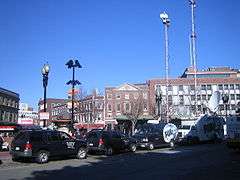
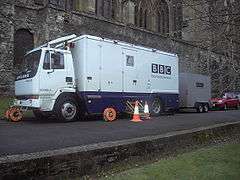 A BBC Radio outside broadcasting van at New College, Oxford
A BBC Radio outside broadcasting van at New College, Oxford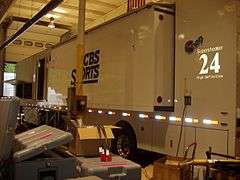 A CBS Sports remote production unit being fabricated in Pittsburgh PA
A CBS Sports remote production unit being fabricated in Pittsburgh PA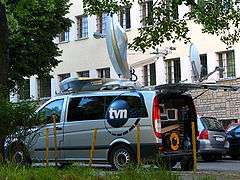 A TVN24 outside broadcasting van in Poznań, Poland
A TVN24 outside broadcasting van in Poznań, Poland- OB for tennis tournament: Extendible-sided production van, satellite dishes, generator truck; see two OB cameras and three announcing booths at top of stadium beyond. Kooyong, Victoria, Australia, 2008
- Arena Television's OB8 working for the BBC at Wimbledon Tennis Championships, UK
- Inside Arena Television OB7's production gallery at the Wimbledon Tennis Championships, UK
 Klotz Digital's Vadis DC II mixer for use at a Virgin Radio outside broadcast at the V Festival 2007
Klotz Digital's Vadis DC II mixer for use at a Virgin Radio outside broadcast at the V Festival 2007
See also
| Wikimedia Commons has media related to Outside broadcasting van. |
External links
- Recreation of a full 1970s BBC Outside Broadcast production
- Technical planning stage of a 1970s Outside Broadcast production
- Demonstration of the 'lining up' process for EMI 2001 OB camera from the 1970s
- Discussion and demonstration of the microphone and communications set up for a sports OB
- BBC Outside Broadcast crew reflect on their careers in OB production
- TV Outside Broadcast History Website
References
- ↑ "TV OUTSIDE BROADCAST HISTORY". TV Outside Broadcast History. Retrieved 2018-05-28.
- ↑ John, Ellis,; Nick, Hall, (2017-11-09). "ADAPT". figshare. doi:10.17637/rh.c.3925603.v1.
- ↑ http://www.satsig.net/latency.htm
- ↑ http://chimera.labs.oreilly.com/books/1230000000545/ch07.html#_brief_history_of_the_g_8217_s